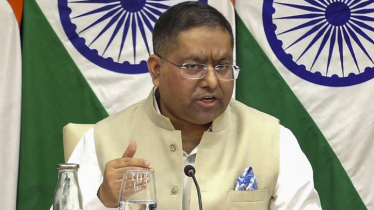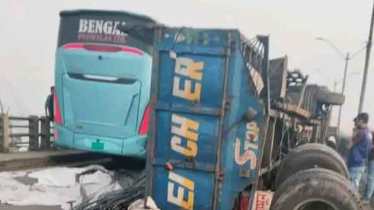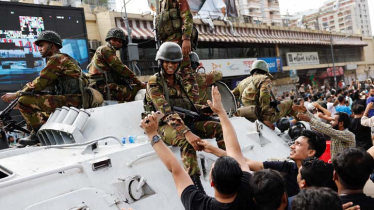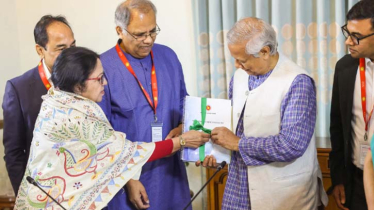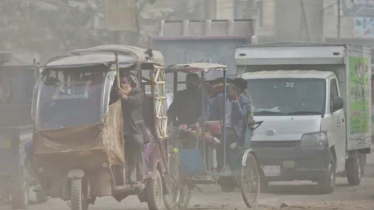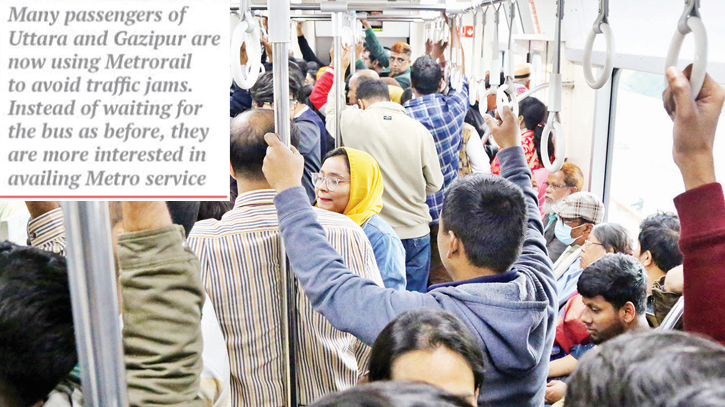
Photo : Messenger
Since last Saturday (January 20), the Metrorail service has been operating between Uttara and Motijheel from 7:10 am to 8:40 pm, leading to a significant shift in commuter preferences. This change has resulted in a passenger crisis for buses operating in various areas of Greater Mirpur, causing financial losses for bus owners.
In response to the altered commuting patterns, bus owners are contemplating changing their routes to adapt to the new situation and mitigate the financial challenges they are currently facing.
According to sources within the Bus Owners Association, a considerable number of passengers from Uttara and Gazipur have switched to using Metrorail to bypass traffic congestion. Instead of waiting for buses as they did previously, passengers are now more inclined to opt for the Metrorail at stations. Consequently, the buses have experienced a substantial decline in both the number of passengers and overall revenue, which has nearly halved.
Observations on Thursday (January 25) revealed a notable change at bus stands in various areas such as Motijheel, Paltan, Shahbagh, Farmgate, and Mirpur. Buses were observed waiting for passengers at most stands, reflecting the decline in commuter numbers.
During interactions with bus personnel, it was noted that buses are struggling to attract passengers, particularly on shorter routes, as more people opt for the convenience of the Metrorail. This shift in commuter behavior has led to a noticeable reduction in the presence of buses from different companies on these routes compared to the pre-Metrorail era.
A helper named Manik from Trans Silva Paribahan said, "Since the daily Metrorail service commenced, we have witnessed a decline in passenger numbers on the Paltan to Mirpur route. Earlier, we used to get a lot of passengers at the Paltan junction. Suddenly, the situation has changed.”
A passenger named Arafat Rahman expressed how the introduction of the metro rail system has significantly improved his daily commute. Living in the Pallabi area and working in Motijheel, he used to allocate at least two hours for his journey. However, with the metro rail in place, he now reaches his office in just 20 minutes, eliminating the need to rely on buses as he did before.
On the flip side, Mahabubur Rahman, the organizing secretary of Dhaka Road Transport Owners Association and owner of Bikalpa Paribahan, highlighted the adverse impact on the income of traditional bus services. He mentioned that their earnings have halved due to the extension of metro rail services, as a significant portion of passengers on the Mirpur-Motijheel route has shifted to the more efficient metro rail. If the situation persists, he expressed concerns about the viability of their current route and the financial challenges of operating at a loss.
Another passenger, Mahmudul Hasan, shared his positive experience with the metro rail. Previously commuting from Paltan to Karwan Bazar by bus, he now chooses the metro rail option. Despite the shorter distance, the old and low-quality buses made the journey challenging, taking 40 minutes to an hour due to traffic jams. With the metro rail, he can complete the same journey in just 10 minutes, highlighting the time and convenience benefits.
According to Bangladesh Road Transport Authority (BRTA) data it was known that that current state of the bus industry is really grim as one in five buses in the capital is deemed unfit, with 3,974 buses reported to be operating under 75 companies. However, transport sector officials argue that the actual number of buses exceeds 5,000, belonging to at least 120 companies.
It is known that a significant portion of unaccounted buses is operating illegally, often managing to do so through dubious connections with higher-ranking officials.
Nasir Uddin Khokon, managing director of Bihanga Paribahan, acknowledged the need for improvements in the quality and service of buses to sustain the business. He emphasized that, despite the availability of the Metrorail, there will still be passengers who choose to use buses for their commute. To cater to this segment, he expressed the commitment to enhance the quality of their buses, aiming to attract passengers who value improved services.
M A N Siddique, Managing Director of Dhaka Mass Transit Company Limited, provided insights into the success of the Metrorail service. He mentioned that after the launch of the Uttara to Motijheel line in the second phase, daily ridership ranged from 130,000 to 160,000 passengers. Notably, with the introduction of a full-day service, stopping at all stations, the daily passenger count has surged to approximately 250,000.
It may be mentioned that Prime Minister Sheikh Hasina inaugurated the Metrorail on December 28, 2022, initiating the first phase from Uttara to Agargaon, operating six days a week from 8 AM to 12 noon.
The Motijheel section from Agargaon was inaugurated in the second phase on November 4, 2023. The Dhaka Metrorail was officially launched on December 31, 2023, with services stopping at all stations from Uttara to Motijheel, maintaining the initial schedule.
In the third phase, train operations from Uttara to Motijheel commenced from January 20, operating daily from 7:10 am to 8:40 pm. It was noted that the Metrorail continues to follow this schedule every day except Fridays.
Messenger/Fameema

